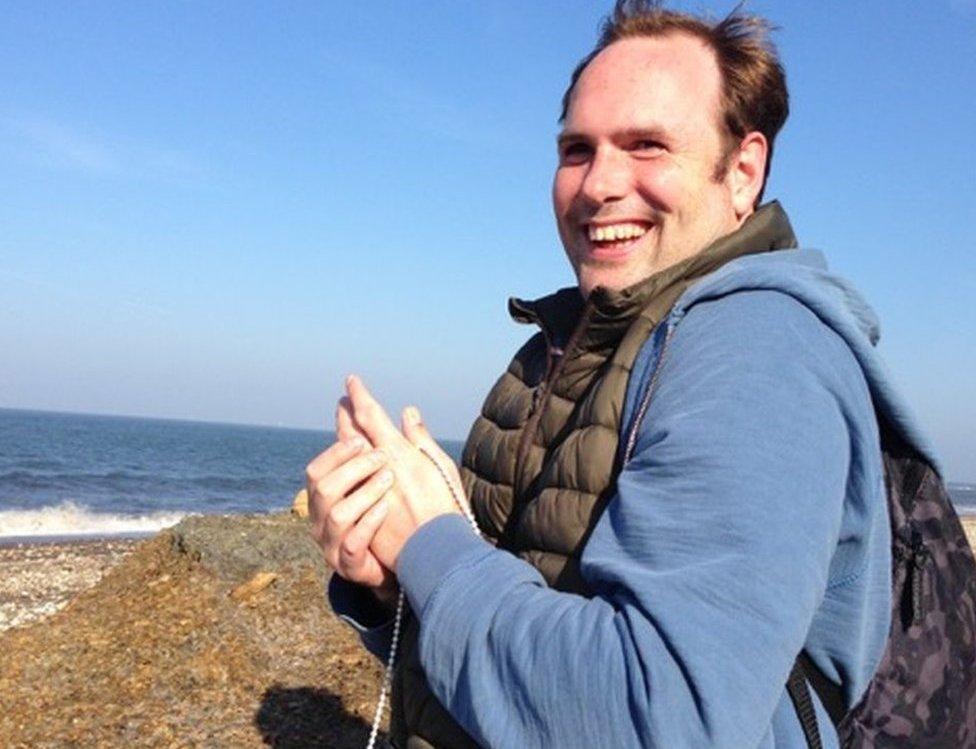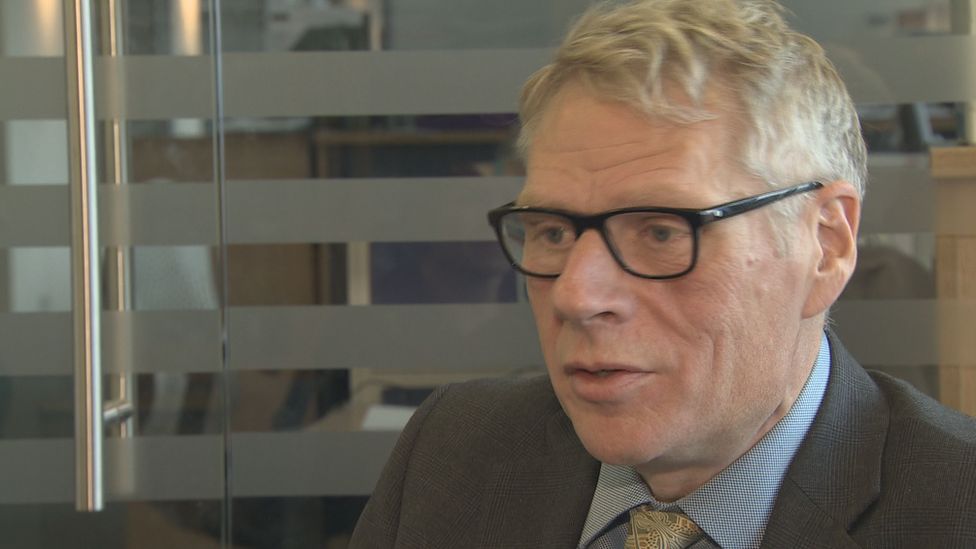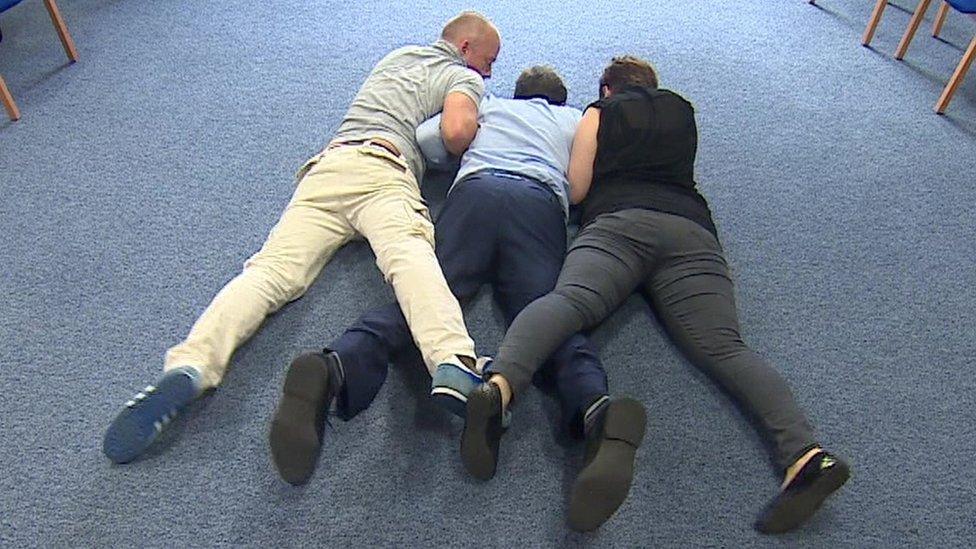Learning disabilities care 'far from home'
- Published
Tracey wants her disabled son to be released from Carstairs
New figures obtained by BBC Scotland show that people with learning disabilities and autism are still being forced to live far from their families.
This is despite a Scottish government pledge five years ago to end the practice.
The BBC also found the number of people with learning disabilities unable to leave hospital units was increasing.
The Scottish government said work had been done to identify the gaps and it was committed to addressing the issue.
In 2013, the government said that "by 2018 people with learning disabilities and autism and complex care needs who are currently in facilities outwith Scotland should be supported to live nearer their family in Scotland".

Dr Anne MacDonald has studied the issue for the Scottish government
However, data obtained by the BBC showed there were 79 people from Scotland still in care homes and hospitals in England and Wales.
The figures come from a study carried out by Dr Anne MacDonald, who has been seconded in to the Scottish government to assess the numbers of people who are still trapped in hospital units and, separately, those stuck a long way from family.
Across the UK the policy direction is to move everyone with learning disabilities into community provision close to families or to being supported in their own homes.
Good examples
But the study found that more than 400 people were still in care homes and hospitals out of their local area, not through choice.
It said 109 of them needed to be brought home as a priority.
Dr MacDonald, project lead for the Keys to Life Project, told the BBC those in the 109 group were of particular concern.
She said: "I think it is absolutely clear that anybody with a learning disability can be in their local community and indeed should be.
"It is about getting these services right for individuals."
Dr MacDonald said there were many good examples around the country of individuals with learning disabilities and complex care needs getting the right services close to home.
Positive methods
However, she said: "It is just unfortunate there are also lots of examples of where this isn't happening and these are the ones we want to focus on going forward to see what we can do better to ensure all people are able to come back and live in their local communities and lead successful lives like the rest of us."
Dr MacDonald also looked at the use of restraint for the 109 people requiring to be brought nearer their families.
She found 21% were subject to physical restraint, 11% subject to seclusion and 44% had their behaviour managed with sedatives.
The doctor said she was disappointed that more positive methods were not being used instead of restraint.
She said there was evidence that chemical restraint was ineffective and that physical restraint could cause long-term damage.
The policy to move people out of institutional care and closer to family follows decades of promises to get people with learning disabilities out of big hospital institutions and into the community but a number seem to have become stuck in the system.

'He keeps telling us he wants to come home'

Louis was sent to a care facility in Hartlepool, a four-and-a-half hour drive away from his family
Kate Sainsbury says her son Louis was born perfect.
But when he was just a few days old he contracted meningitis.
Louis's brain was damaged. As a result he has learning disabilities and his communication is impaired.
"Louis is tall and strong and charming," she said.
He went to a residential school and went home at weekends but at the end of school he struggled and ended up in a hospital inpatient unit.
'It's desperate'
"After that it was really difficult getting a suitable placement for Louis," Kate said.
And then earlier this year he lost his placement of six years.
"Last summer his biological father died and Louis understandably acted out. He was evicted from his placement and then we couldn't find anywhere for him and the only place the social worker could find was in Hartlepool.
"For him the move was really frightening. It was a bereavement of everything he had known.
"It's desperate. I drive down every fortnight but it takes four-and-a-half hours to get there.
"We're looking to move Louis to a flat near us where he can be supported but it's proven really hard. He can communicate and he just keeps telling us he wants to come home."

Colin Mackay, chief executive of the Mental Welfare Commission (MWC), said there was great momentum in the 1980s and 1990s to get people out of institutional care but that it had stalled.
He said: "My worry now is that we have lost that sense of ambition and drive and that what is happening just now isn't acceptable and we need to do something to resolve it."
He told the BBC the numbers of people with learning disabilities stuck and unable to leave hospital units should be going down but was actually growing.

Colin Mackay from the Mental Welfare Commission said momentum had stalled
A report the commission carried out in 2016 found there were about 58 people with learning disabilities and autism who had been assessed as ready to leave inpatient care but whose discharge has been delayed because of a lack of provision in the community - sometimes for months and even years.
A recent check found the figure had gone up to 78.
The Scottish government's most recent Programme for Government does not mention the 2013 target but talks about reducing out-of-area placements from autumn 2018 onwards.
Inpatient care
It said Dr MacDonald's work meant they were much better informed about the gaps in services and were able to address them.
Clare Haughey, the minister for mental health, said: "We are committed to considering how best to take forward work based on Dr MacDonald's findings, including discussing this with Health and Social Care Partnerships in relation to the commissioning of local services, developing community services, transition planning and specialist skills."
The BBC's File on 4 radio programme has revealed the use of restraint in inpatient units in England has risen sharply and that thousands of people with learning disabilities are still trapped in institutional care across the UK.
Transforming Care - Is It Working? is on BBC Radio 4 at 8pm on Tuesday.
- Published2 October 2018
